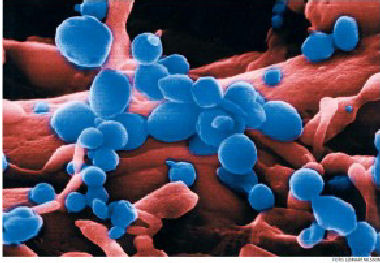This week we have started Chapter 4: Cell Replication, looking at how cells divide for growth, maintenance and repair. Watch the Cells Alive animation that shows the four stages of Mitosis – Prophase, Metaphase, Anaphase and Telophase. The in-between phase is Interphase, when the chromosomes are not visible. What stage is shown in the electron micrograph above? How can you tell?
This site, at NOVA Online, shows how mitosis and meiosis compare. The McGraw-Hill site also has a good animation showing mitosis and cytokinesis (division of cytoplasm and formation of two separate cells).
The most recent edition of New Scientist has an interesting article about how bone cells form – bone marrow cells can be induced to form bone, fat or blood depending on chemical and physical cues. In an experiment performed at the University of Chicago, scientists induced bone marrow cells to form bone cells in angular moulds (star-shaped or rectangular) and fat cells in curvy moulds (circles and flower shapes).







